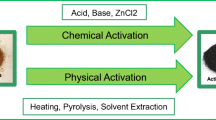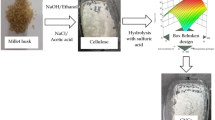Abstract
Mineral adsorbents, such as talc, are materials that are abundant in nature and used as scavengers, binding agents, fillers, etc. Mechanical and physicochemical pretreatment creates new opportunities for the production of highly effective mineral materials with a wide range of destinations. The possibility of using various techniques to enhance the adsorption properties of dispersed talc, namely, enrichment and use in a mixture with another mineral, treatment with various reagents, and changing the temperature and acidity conditions, is demonstrated. Phenomena and trends having an effect on the adsorption ability of talc are considered. Surface modification of talc can significantly increase its technological capability of absorbing resinous components of wood pulp in the manufacture of paper. It is shown that the adsorption and structural characteristics of dispersed talc change significantly after modifying it with organic reagents. The best effect is achieved when pretreating talc with cationic surfactant N-cetylpyridinium chloride. The resulting adsorbent is characterized by a high value of rosin adsorption, reaching 200 mg/g, which is commensurate with the data on the absorption of rosin by talc pretreated with a Penta-416 industrial mixture. Substantial changes in the surface properties due to an increase in the temperature, a change in the acidity, and a shift in the hydrophilic-hydrophobic balance occur when using the accessible, affordable, and safe anionic surfactants. The highest value of adsorption of rosin (160–170 mg/g) is typical for samples of talc modified with sodium oleate and enriched with zinc oxide. The importance of pretreatment of talc with solutions of mineral acids and salts that promote settling of suspensions and the formation of a compact precipitate is shown.



Similar content being viewed by others
REFERENCES
Novyi spravochnik khimika i tekhnologa. Syr’e i produkty promyshlennosti organicheskikh i neorganicheskikh veshchestv (The New Reference Book of Chemist and Technologist. Raw Materials and Products of Industrial Organic and Inorganic Substances), St. Petersburg: Professional, 2010, part 1.
Lapin, V.V., Tsellyul., Bum., Karton, 2006, no. 4, pp. 56–58.
Puzyrev, S.S., Tyurin, E.T., and Kovaleva, O.P., Tsellyul., Bum., Karton, 2006, no. 9, pp. 66–70.
Azarov, V.I., Burov, A.V., and Obolenskaya, A.V., Khimiya drevesiny i sinteticheskikh polimerov (Chemistry of Wood and Synthetic Polymers), Moscow: Lan’, 2010.
Nazarenko, V.V., Tsellyul., Bum., Karton, 2010, no. 3, p. 36.
Adsorption from Solution at the Solid/Liquid Interface, Parfitt, G. and Rochester, C., Eds., New York: Academic Press, 1983.
Strel'nikova, O.Yu., Bel’chinskaya, L.I., and Petukhova, G.A., in Aktual’nye problemy teorii adsorbtsii, poristosti i adsorbtsionnoi selektivnosti (Modern Problems of Adsorption Theory, Porosity, and Adsorption Selectivity), Moscow, 2010, p. 110.
Shchukin, E.D., Pertsov, A.V., and Amelina, E.A., Kolloidnaya khimiya (Colloid and Surface Chemistry), Moscow: Vysshaya Shkola, 2006.
Chyong, S.N., Cand. Sci. (Chem.) Dissertation, Irkutsk: Irkutsk State Technical Univ., 2012.
Tarasevich, Yu.I., Stroenie i khimiya poverkhnosti sloistykh silikatov (The Structure and Surface Chemistry of Layered Silicates), Kiev: Naukova Dumka, 1988.
Ferrage, E., Martin, F., Boudet, A., et al., J. Mater. Sci., 2002, vol. 37, pp. 1561–1573.
Jenkins, P. and Ralston, J., Colloids Surf., A, 1998, vol. 139, pp. 27–40.
Yakovleva, A.A., in Sovremennye problemy adsorbtsii (Modern Problems of Adsorption), Moscow: Granitsa, 2013, p. 125.
Schumann, W., Steine und Mineralien: mineralien, edelsteine, gesteine, erze, Bern: BLV, 1977.
Yakovleva, A.A., Chyong, S.N., Pridatchenko, Yu.V., et al., Izv. VUZov, Prikl. Khim. Biotekhnol., 2013, no. 1, pp. 105–111.
Yakovleva, A.A., Kolloidnaya khimiya (Colloid Chemistry), Irkutsk: Irkutsk State Technical Univ., 2013.
Yakovleva, A.A., Chyong, S.N., and Le, M.L., Izv. Vyssh. Uchebn. Zaved., Khim. Khim. Tekhnol., 2015, no. 2, pp. 22–26.
Yakovleva, A.A. and Chyong, S.N., Izv. VUZov, Prikl. Khim. Biotekhnol., 2011, no. 1, pp. 72–77.
Yakovleva, A.A. and Chyong, S.N., Vestn. Irkutsk. Gos. Tech. Univ., 2010, no. 5, pp. 224–229.
Yakovleva, A.A., Izv. VUZov, Prikl. Khim. Biotekhnol., 2014, no. 5, pp. 7–14.
Zhang, R. and Somasundaran, P., Adv. Colloid Interface Sci., 2006, vols. 123–126, pp. 213–229.
Yakovleva, A.A., Chyong, S.N., and Le, M.L., Vestn. Irkutsk. Gos. Tech. Univ., 2011, vol. 48, no. 1, pp. 143–147.
Rusanov, A.I. and Shchekin, A.K., Mitselloobrazovanie v rastvorakh poverkhnostno-aktivnykh veshchestv (Micellization in Surfactant Solutions), St. Petersburg: Khimiya, 2016.
Fomkin, A.A., in Aktual’nye problemy teorii adsorbtsii, poristosti i adsorbtsionnoi selektivnosti (Modern Problems of Adsorption Theory, Porosity, and Adsorption Selectivity), Moscow, 2010, p. 23.
Yakovleva, A.A. and Chyong, S.N., Izv. Vyssh. Uchebn. Zaved., Khim. Khim. Tekhnol., 2012, vol. 55, no. 4, pp. 47–51.
Takanori, M., Yasuyuki, K., and Hiroshi, O., Tappi J., 2000, vol. 83, no. 7, pp. 1–7.
Yakovleva, A.A. and Rybina, M.N., in Aktual’nye problemy khimii i biotekhnologii (Modern Problems of Chemistry and Biotechnology), Irkutsk: Irkutsk State Technical Univ., 2015, pp. 31–33.
Yakovleva, A.A. and Bocharova, M.A., Vestn. Irkutsk. Gos. Tech. Univ., 2009, no. 1, pp. 181–186.
Yakovleva, A.A. and Mal’tseva, G.D., Izv. VUZov, Prikl. Khim. Biotekhnol., 2015, no. 2, pp. 16–23.
Yakovleva, A.A., in Aktual’nye problemy teorii adsorbtsii, poristosti i adsorbtsionnoi selektivnosti (Modern Problems of Adsorption Theory, Porosity, and Adsorption Selectivity), Moscow: Granitsa, 2014, p. 125.
Yakovleva, A.A. and Rybina, M.N., in Aktual’nye problemy teorii adsorbtsii, poristosti i adsorbtsionnoi selektivnosti (Modern Problems of Adsorption Theory, Porosity, and Adsorption Selectivity), Moscow: Granitsa, 2015, p. 118.
Ferrage, E., Seine, G., Gaillot, A.C., et al., Eur. J. Mineral., 2006, vol. 18, pp. 483–491.
Fomkin, A.A., in Aktual’nye problemy teorii adsorbtsii, poristosti i adsorbtsionnoi selektivnosti (Modern Problems of Adsorption Theory, Porosity, and Adsorption Selectivity), Moscow, 2015, p. 7.
Author information
Authors and Affiliations
Corresponding author
Additional information
Translated by O. Kadkin
Rights and permissions
About this article
Cite this article
Yakovleva, A.A. Analysis of Techniques for Improving the Adsorption Capacity of Talc. Prot Met Phys Chem Surf 55, 439–444 (2019). https://doi.org/10.1134/S2070205119030286
Received:
Revised:
Accepted:
Published:
Issue Date:
DOI: https://doi.org/10.1134/S2070205119030286




